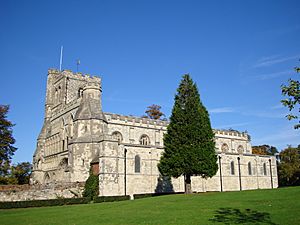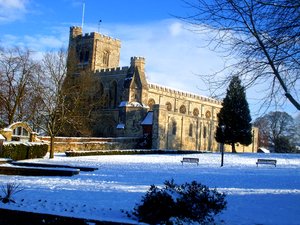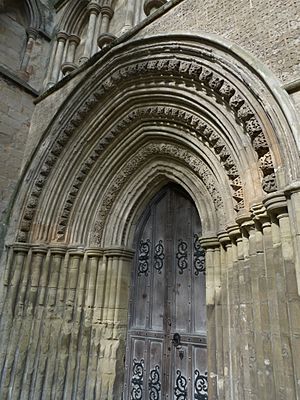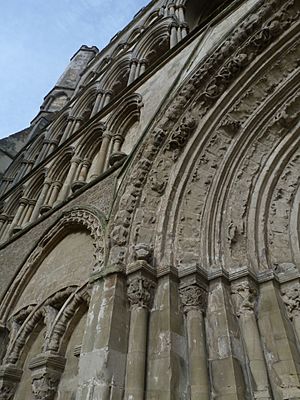Dunstable Priory facts for kids
Quick facts for kids The Priory Church, Dunstable |
|
|---|---|
| The Priory Church of St. Peter, Dunstable | |
 |
|
| Location | Church Street, Dunstable, LU5 4NA |
| Country | United Kingdom |
| Denomination | Church of England |
| Website | http://www.dunstableparish.org.uk/ |
| History | |
| Founded | 1132 |
| Founder(s) | King Henry I |
| Administration | |
| Parish | Dunstable |
| Diocese | St Albans |
The Priory Church of St Peter in Dunstable was once part of a large monastery called Dunstable Priory. It was started in 1132 by King Henry I. He built it for a group of religious men called Augustinian Canons. These canons lived together and followed strict rules.
Today, St Peter's Church is only the main part (called the nave) of the much bigger original church. The monastery used to have many buildings. These included places for the monks to sleep, a hospital, stables, and workshops. There was also a place for visitors and pilgrims to stay. This building is now known as Priory House. Near the Priory was one of King Henry I's palaces, called Kingsbury.
The church you see today is part of the Archdeaconry of Bedford. This is a region within the Diocese of St Albans. The church is very important historically. It became a Grade I listed building on October 25, 1951. This means it is a building of special architectural or historic interest.
Contents
Exploring Dunstable Priory's Design
St Peter's Church is a great example of Norman architecture in England. This style was popular after the Norman Conquest. The church was built in the shape of a cross. It had a large tower in the middle and two smaller towers at the west end. It took about 70 to 80 years to finish building the church.
About ten years after it was finished, a big storm damaged the front of the church. This damaged part was rebuilt in the Early English style. This style is known for its tall, narrow windows and pointed arches. The west front has a huge entrance with four arches. These arches were built between 1170 and 1190. Below them is a doorway from the 15th century. The entrance is decorated with patterns and carvings.
To the southwest of the church is a 15th-century gateway. This gateway is a reminder of the priory that no longer exists. The old west doors of the church still show marks from shots fired during the English Civil War.
Inside the church, a special feature is the beautiful 14th-century screen. This screen has five open sections. The roof was carefully repaired in 1871. It looks like the original roof from the Perpendicular style. You can also see several old tombs and brass plaques on the floor. One important item the church owns is the Fayrey Pall. This is a special embroidered cloth from the 15th century.
A Look at Dunstable Priory's Past
The Augustinian priory of Dunstable was founded by King Henry I around 1132. He gave the priory control of the land and town where it stood. Some stories say the king also started the town. He supposedly cleared the forest where two old roads, Watling Street and the Icknield Way, crossed. This was to get rid of robbers.
King Henry I gave the priory many freedoms and rights in Dunstable. These were the same rights he had in his own lands. King Henry II later confirmed these rights. He also gave the priory control of Houghton Regis. Before the time of King Richard I, many nearby churches were also given to the priory. These gifts came from thirteen different people. The priory also gained control of the chapel of Ruxox and parts of other towns. Some of these gifts were argued over later, but the priory kept most of them.
Bernard was the first prior, or head, of the monastery. He helped bring the Austin Canons to England. He traveled to France to learn their rules. This helped introduce the Augustinian way of life in England.
The 13th Century: Growth and Challenges
In 1202, Richard de Morins became the prior of Dunstable. With his leadership, the priory became very important. He started writing down the history of Dunstable in 1210. He was a very busy and capable person. Soon after becoming prior, he went to Rome for the king. His influence likely helped the priory keep control of Houghton Regis.
Richard de Morins traveled abroad only once more. He attended an important church meeting in 1215. Afterward, he stayed in Paris for a year to study. The records show he was always interested in events across Europe. In 1206, he was chosen to inspect other religious houses. In 1212, the pope asked him to preach in several counties. He also helped estimate losses suffered by the clergy due to King John's demands.
He inspected his own order in 1223 and 1228. In 1239, he helped solve problems between church leaders. During his time, in 1219, he gained the right to hold a court in Dunstable. He could also sit with royal judges. This caused some problems with the townspeople. They revolted against his authority in 1228. He also successfully secured the right to the Harlington church in 1223.
King Henry III visited the priory twice during Richard de Morins' time. Once was after a siege, and again during the troubles with the townspeople. The king tried to calm things down at the prior's request.
Despite problems with King John and the townspeople, the priory was very successful then. In 1213, the church was officially dedicated. Many important people attended the ceremony. The priory lost Houghton Regis for a short time in 1212 but got it back in 1226. They also received the church of Bradbourne. This gift helped support three canons and increased the priory's income.
Richard de Morins died in 1242. After his death, the priory faced many difficulties. In 1243, 800 of their sheep died. Bad weather led to food shortages. The cellarer, Henry de Bilenda, who managed supplies, was not good at his job. In 1249, he ran away to the Cistercian monks to avoid accounting for his work. By 1255, the canons had no grain to sell. They even had to buy all their own food for two years. So, when the Friars Preachers arrived in 1259, they were not very welcome. When Simon of Eaton became prior in 1262, the priory was deeply in debt.
Even with debt and poverty, the prior was interested in public events. Like many church leaders then, he supported Simon de Montfort. He saw Montfort as a defender of the Church. In 1263, when Montfort visited Dunstable, the prior welcomed him. He even made him a member of the priory's community. In 1265, a meeting was held at Dunstable to discuss peace. The king and queen visited the priory that year. Even though the prior supported Montfort, the priory was not punished for it.
In 1274, a long and costly legal fight began. It was between the priory and Eudo la Zouche. Eudo refused to accept the prior's right to have a gallows and prison in Houghton. He released one of his men from the prison and tore down the gallows. Under the next prior, William le Breton, the gallows was put back up. But Eudo still refused to accept the prison. He even built his own gallows. The dispute continued for years. After Eudo died, his wife, Millicent, continued the fight. Finally, in 1289, the court decided in favor of the prior.
The priory's poverty and problems grew. After William le Breton was removed from his position in 1279, big efforts were made to save money. They tried to get cash to pay off debts. They granted special rights to people in exchange for money. Manors and churches were rented out. In 1294, the money usually given for one canon had to support two. At this time, the king was also asking for money for his war.
The priory faced more bad luck. In the same winter, their outer walls fell down due to wet weather. Their haystacks were destroyed by fire. They also owed a lot of money to the Hospitallers. In 1295, the house at Bradbourne was so poor that all its wool had to support the three brothers who served there. The later records of the priory tell a long story of poverty. They struggled to get out of debt. The story ends sadly with the costs of installing a new prior, John of Cheddington. These costs, plus old debts, totaled a huge amount of money.
Dunstable Priory's Ancient Clock
The Dunstable Priory clock was one of the oldest mechanical clocks in England. It was built in 1283. Records say it was placed above the rood screen, which separated the church's nave from the choir.
From the 14th to 16th Centuries
There are not many records from the 14th century. The main events recorded are about the Peasants' Revolt in 1381. During this time, the prior, Thomas Marshall, showed great courage. He managed to protect his monastery from serious harm. He also saved the townspeople from punishment. In 1349, an attempt was made to claim that the prior held his lands like a baron. But a jury swore that the lands had always been held as pure gifts for religious purposes.
King Henry VI visited Dunstable in 1459. However, there are no records about his relationship with the priory. The priory's history during the 15th century is not well recorded.
In the 16th century, the priory was involved in a very important historical event. On May 23, 1533, Archbishop Cranmer and other bishops made a big announcement. They declared that the marriage between King Henry VIII and Catherine of Aragon was not valid. This happened in the Lady Chapel of the church at Dunstable. The location was chosen because Catherine was staying nearby in Ampthill.
In 1535, the prior, Gervase Markham, and twelve canons signed a document. They agreed to the King's authority over the Church. On January 20, 1540, Markham gave the priory to the king. He then received a pension of £60.
The smaller religious houses in England were closed by law in 1536. Dunstable Priory and its church were closed in January 1540. The prior and the twelve canons received pensions. They were also allowed to become regular priests. The large church and priory buildings were first kept intact. The plan was to make Dunstable a new church center, with the priory church as its main cathedral.
However, the plan for new bishoprics did not happen. After a few years, the beautiful church, except for the part used by the local people, was destroyed. Like the other monastery buildings, it was stripped of anything valuable and left in ruins.
At the time it closed, there were only thirteen monks. This included the prior, eleven canons, and two lay brothers. In earlier times, there were probably more. Between 1223 and 1275, only twenty-five new members joined. Thirteen members died. Besides the religious members, there were other people living at the priory. A new building for carpenters was built in 1250. There was also space for the monastery's chaplains. People who bought special living rights also stayed there. The gatekeeper was sometimes a regular person, not a monk.
Church Inspections (Visitations)
The priory was well-run during Richard de Morins' time. He was chosen twice to inspect other monasteries. This shows he managed his own house carefully. During his forty years as prior, canons from Dunstable were chosen to lead other monasteries five times.
Bishop Grosseteste visited the priory in 1236. He mainly checked the priory's rights to several churches. He made all the canons take an oath. One canon ran away to Woburn to avoid it. The bishop came again in 1248. The cellarer, accused of problems, ran away before he arrived. But the bishop did not seem to find fault with the general community. His next visit in 1250 was for his own reasons. Archbishop Boniface visited in 1253 and had no complaints.
In 1274, Bishop Gravesend sent a canon from Lincoln to visit Dunstable. He left written instructions for improvements. In the same year, the bishop visited in person. In November 1279, Bishop Sutton visited and was very strict. The sub-prior and others were removed from their jobs. Some "less useful members" were sent away. In May of the next year, he removed Prior William le Breton from his leadership role.
These removals were likely due to poor management, not personal faults. The priory was in great debt. It needed strong actions, and William le Breton could not handle the problems. There is no sign of other serious wrongdoings or luxurious living. The new prior, following the bishop's advice, worked to cut costs. He set a fixed budget for the kitchen. The removed prior was given proper support at Ruxox. The canons seemed to have no hard feelings towards Bishop Sutton. When he visited again, they praised his excellent sermon.
Other visits by Bishop Sutton are mentioned in 1284, 1287, 1288, and 1293. The last one was only to ordain new priests. Archbishop Peckham visited in 1284 and found everything in order. Archbishop Winchelsea visited in 1293. The main problem for the canons in the 13th century was their debt. The records show this was often due to bad luck, not their fault.
The chroniclers' notes show that the priory was very religious. The canons followed their rules faithfully. For example, early in the century, two young canons ran away to join the Friars Minor in Oxford. They were excommunicated and forced to return. But after they did their penance, they were given a year to decide. If they still preferred the stricter order, they could leave. If not, they could stay at Dunstable. Later, in 1283, the chronicler carefully explained when the prior went out to dinner. This shows that breaking the rules was not common.
During the 14th century, there were several inspections. Bishop Dalderby did not visit himself. But in 1315, he asked the prior of Dunstable to visit some nuns for him. In 1322, Bishop Burghersh ordered the priory to take back a brother. This brother had gone on a pilgrimage to the Holy Land. The prior was later criticized for not obeying this order.
In 1359, Bishop Gynwell passed by the priory. He noticed some canons wandering outside the monastery without permission. He wrote to remind them of the rule. Canons should not leave the monastery without a good reason and the prior's permission. He also said permission should not be given too often. He reminded them not to eat or drink outside the monastery. They also should not talk with non-religious people without permission.
In 1379, Bishop Buckingham approved an important rule by Thomas Marshall. This rule set aside money to educate one of the canons at Oxford. The prior mentioned the priory's poverty. He said they could not live properly without help from friends. He wanted to support a canon's studies. This was partly from money given by his own family. He saw the importance of learning and preaching. Dunstable was a busy place where many people gathered. All this suggests the priory was in good shape under Thomas Marshall.
Bishop Grey's instructions are the only records of the priory's internal life in the 15th century. They do not show any special problems. They just repeated the usual rules. These included rules about silence, singing church services, and not eating or drinking after Compline (a night prayer). They also covered not going to Dunstable or having visitors without permission.
Finally, just before the priory closed, Bishop Longland was silent about any issues. Also, the king chose the priory for his divorce announcement. These facts suggest the priory was generally well-behaved. Overall, Dunstable Priory had a good record for discipline and order. There were only a few minor problems.
Priory's Wealth and Property
The priory's first gift was control of the manor and town of Dunstable. Under Henry II, they also gained control of Houghton Regis. Under King John, they received the king's house and gardens in Dunstable. The manors of Stoke and Catesby were also mentioned as priory property in the 13th century.
In 1291, Dunstable Priory owned the rights to tithes (church taxes) from many churches. These included churches in Bedford, Dunstable, and other towns. They also received payments from other churches. At this time, their temporary income was valued at a little over £50. The priory's records state their total income in 1273 was £107.
The priory's total property value in 1535 was £344 13s. 4d. The first report from the king's manager valued it at £266 17s. 6¾d. This included manors like Studham and rectories (church properties) in many towns.
Leaders of Dunstable Priory
Here are the Priors of Dunstable:
- Bernard
- Cuthbert
- Thomas, served 1185, resigned 1202
- Richard de Morins, elected 1202, died 1242
- Geoffrey of Barton, elected 1242, resigned 1262
- Simon of Eaton, elected 1262, died 1274
- William le Breton, elected 1274, removed 1280
- William de Wederhore, elected 1280, resigned 1302
- John of Cheddington, elected 1302, died 1341
- John of London, elected 1341, resigned 1348
- Roger of Gravenhurst, elected 1348, died 1351
- Thomas Marshall, elected 1351, died 1413
- John Roxton, elected 1413, resigned 1473
- Thomas Gylys, elected 1473, resigned 1482
- Richard Charnock, elected 1482, resigned 1500
- John Wastell, elected 1500, died 1525
- Gervase Markham, elected 1525, surrendered 1540
Priory's Official Seal
The official seal used by the priory in the 15th century was round and large. It showed St. Peter sitting down. He held keys in his left hand and raised his right hand in blessing. The words around it said: SIGILLUM ECCLIE SC . . PET . . LE (meaning "Seal of the Church of St. Peter").
The seal of Prior William de Wederhore (from a document in 1286) looked similar. His personal counter-seal showed a king and a saint standing under decorated arches. The prior was kneeling in prayer below them. The words on it said: . . . . ILLUM WILLELMI PRIORIS DE. . (meaning "Seal of William, Prior of...").
Burials





